Picture |
Object
name
#NORAD |
Description |
Launch
Date |
Weight |
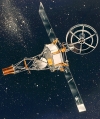
|
Mariner-2
Mariner-Venus 1962
#00374
(1962-041A) |
The Mariner 2 spacecraft
was the second of a series of spacecraft used for planetary
exploration in the fly-by, or non-landing, mode and
the first spacecraft to successfully encounter another
planet. Mariner 2 was a backup for the Mariner 1 mission
which failed shortly after launch to Venus. The objective
of the Mariner 2 mission was to fly by Venus and return
data on the planet's atmosphere, magnetic field, charged
particle environment, and mass. |
Aug 27th
1962 |
202.8 kg |
 This
recording is from vinyl no. 51 which was included in
the Italian Enciclopaedia L’uomo e lo spazio (The man
and the space) issued 1965 by Fratelli Fabbri. Digitized
and kindly provided by Federico Manzini This
recording is from vinyl no. 51 which was included in
the Italian Enciclopaedia L’uomo e lo spazio (The man
and the space) issued 1965 by Fratelli Fabbri. Digitized
and kindly provided by Federico Manzini
|
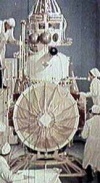
|
Cosmos
359
#04501
(1970-065A) |
 This mission
was an attempted Venus flight, probably lander similar
to the Venera 7 mission launched 5 days earlier on August
17th. The SL-6/A-2-e launcher
successfully brought the spacecraft to Earth orbit and
the spacecraft payload was separated from the Tyazheliy
Sputnik, but the escape stage failed during firing,
putting the payload into a slightly more elliptical
geocentric orbit. This mission
was an attempted Venus flight, probably lander similar
to the Venera 7 mission launched 5 days earlier on August
17th. The SL-6/A-2-e launcher
successfully brought the spacecraft to Earth orbit and
the spacecraft payload was separated from the Tyazheliy
Sputnik, but the escape stage failed during firing,
putting the payload into a slightly more elliptical
geocentric orbit.
Since 1962 the name Cosmos was
given to Soviet spacecrafts which remained in Earth
orbit, regardless of whether that was their intended
final destination. Typically Soviet planetary missions
were initially put into an Earth parking orbit as a
launch platform with a rocket engine and attached probe.
The probes were then launched toward their targets with
an engine burn of roughly 4 minutes. If the engine misfired
or the burn was not completed, the probes would be left
in Earth orbit and given a Cosmos designation. Therefore
this mission was designated Cosmos 359.
The failed
Venus probe in violent tumble was received on 66.2 MHz
on August 22nd 1970 at 08:17
UTC by Sven Grahn.
|
Aug 22nd
1970 |
6500 kg |
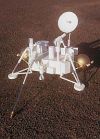

|
Viking
Lander 1
Viking-B Lander
Thomas Mutch Memorial
Station
#09024
(1975-075C) |
The Viking 1 spacecraft
consisted of an orbiter and a lander. After orbiting
Mars and returning images used for landing site selection,
the orbiter and lander detached and on July 20th
1976 the Viking 1 Lander was the first vessel from Earth
which landed and explored the red Martian terrain. The
orbiter continued imaging and conducted other scientific
operations from orbit while the lander deployed instruments
on the surface. Viking 1's Lander continued to explore
the surface of Mars, providing a huge amount of raw
data on the planet and its composition, for more than
6 years before it finally stopped functioning on August
17th 1980. |
Aug
20th 1975 |
572
kg |
 This recording
of the touchdown of the Viking-1 lander on the surface
of Mars is part of the compilation "The Conquest
of Space" of the Astronautical Society of Western
Australia and kindly provided by Jos Heymann. This recording
of the touchdown of the Viking-1 lander on the surface
of Mars is part of the compilation "The Conquest
of Space" of the Astronautical Society of Western
Australia and kindly provided by Jos Heymann.
|
 This recording
of the picture transmission of Viking 1 was published
in 1997 on a tape cassette by the JPL Amateur Radio
Club. Kindly digitized by Christian Schwarze. This recording
of the picture transmission of Viking 1 was published
in 1997 on a tape cassette by the JPL Amateur Radio
Club. Kindly digitized by Christian Schwarze.
|
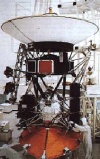

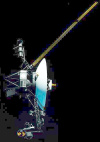
|
Voyager-2
Mariner
Jupiter/Saturn B
#10271
(1977-076A) |
Voyager 2 was one of
a pair of spacecraft launched to explore the planets
of the outer solar system and the interplanetary environment.
Each Voyager had as its major objectives at each planet
to: (1) investigate the circulation, dynamics, structure,
and composition of the planet's atmosphere; (2) characterize
the morphology, geology, and physical state of the satellites
of the planet; (3) provide improved values for the mass,
size, and shape of the planet, its satellites, and any
rings; and, (4) determine the magnetic field structure
and characterize the composition and distribution of
energetic trapped particles and plasma therein. |
Aug 20th 1977 |
722 kg |
 NASA
placed on both spacecrafts Voyager 1 and 2 a disk which
contains messages to communicate a story of our world
to extraterrestrials. The Voyager messages are carried
by a phonograph record. The 12-inch gold-plated copper
disk contains 115 images and a variety of natural sounds
to demonstrate the diversity of life and culture on
Earth. Enclosed please find some of the sounds. NASA
placed on both spacecrafts Voyager 1 and 2 a disk which
contains messages to communicate a story of our world
to extraterrestrials. The Voyager messages are carried
by a phonograph record. The 12-inch gold-plated copper
disk contains 115 images and a variety of natural sounds
to demonstrate the diversity of life and culture on
Earth. Enclosed please find some of the sounds.
birds:  chimpanzee: chimpanzee: f-111 f-111
 fire: fire:
 first: first:
 herding: herding:
 horse: horse:
 kiss: kiss:
 morse: morse:
 tame dog: tame dog:
 volcanoes: volcanoes: wind: wind:

|
  Jovian
Electron Cyclotron Emissions recorded by Voyager-2 PWS
(plasma wave sensor): Jovian electron cyclotron emissions
are intense narrow-banded emissions, generated by energetic
electrons spiraling along the magnetic field lines of
Jupiter and its magnetized moons. The frequency bands
of the electron cyclotron emissions occur at harmonics
or very precise multiples of the electron cyclotron
frequency, a characteristic frequency of the plasma
surrounding the planet. The frequencies of the electron
cyclotron emission bands track the variations in the
electron cyclotron frequency, which varies with the
strength of the magnetic field. The resulting tones
are high- pitched monotones which move up and down in
frequency scale on time scales of seconds to tens of
seconds. Provided by Don Gurnett. Courtesy of NASA and
the University of Iowa. Jovian
Electron Cyclotron Emissions recorded by Voyager-2 PWS
(plasma wave sensor): Jovian electron cyclotron emissions
are intense narrow-banded emissions, generated by energetic
electrons spiraling along the magnetic field lines of
Jupiter and its magnetized moons. The frequency bands
of the electron cyclotron emissions occur at harmonics
or very precise multiples of the electron cyclotron
frequency, a characteristic frequency of the plasma
surrounding the planet. The frequencies of the electron
cyclotron emission bands track the variations in the
electron cyclotron frequency, which varies with the
strength of the magnetic field. The resulting tones
are high- pitched monotones which move up and down in
frequency scale on time scales of seconds to tens of
seconds. Provided by Don Gurnett. Courtesy of NASA and
the University of Iowa.
|
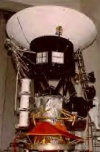
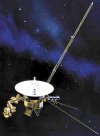
|
Voyager-1
Mariner
Jupiter/Saturn A
#10321
(1977-084A) |
Voyager-1 was launched
only 2 weeks after Voyager-2. Both provided communications
through a high-gain antenna with a low-gain antenna
for backup. The high-gain antenna supported both X-band
(approx. 8420 MHz) and S-band downlink telemetry. |
Sep 5th 1977 |
722 kg |
On January 25th
2010 12:55 UTC Juan Daniel Gallego was able to use the
40m dish antenna of OAN in Yebes, Spain to receive Voyager
1 using a  Perseus
Software Defined receiver. At the time of reception
Voyager was 16.9 billion km away which is about 3.5
times the distance between Earth and Pluto! After converting
the 8.4 GHz signal down to about 3.5 MHz the beacon
signal was finally demodulated using CW detection of
the Perseus SDR receiver with an IF filter BW of 200
Hz. A description of the setup can be found when clicking
on the icon of the dish antenna. Perseus
Software Defined receiver. At the time of reception
Voyager was 16.9 billion km away which is about 3.5
times the distance between Earth and Pluto! After converting
the 8.4 GHz signal down to about 3.5 MHz the beacon
signal was finally demodulated using CW detection of
the Perseus SDR receiver with an IF filter BW of 200
Hz. A description of the setup can be found when clicking
on the icon of the dish antenna.  The
audio recordings below are in non compressed wav format
and thus each 3 MBytes large. This allows you to analyze
the audio with an FFT program like Spectrum lab in case
you are interested. A spectrum capture can be seen by
clicking on the icon on the right. The
audio recordings below are in non compressed wav format
and thus each 3 MBytes large. This allows you to analyze
the audio with an FFT program like Spectrum lab in case
you are interested. A spectrum capture can be seen by
clicking on the icon on the right.
 In the
first recording you can hear the carrier of the beacon.
The signal is approx. 5 dB below noise level but can
be perceived by a trained (ham) ear. In the
first recording you can hear the carrier of the beacon.
The signal is approx. 5 dB below noise level but can
be perceived by a trained (ham) ear.
 In the
second recording the local oscillator of the receiver
is switched 50 Hz up and down in periods of a few seconds.
This makes it much easier to perceive the signal by
the change in pitch even by untrained ears. In the
second recording the local oscillator of the receiver
is switched 50 Hz up and down in periods of a few seconds.
This makes it much easier to perceive the signal by
the change in pitch even by untrained ears.
 Finally
the third audio files contains the same signal from
the beacon (no freq. switching) but compressed in time
by a factor of 50 and repeated 4 times. This makes easier
to appreciate the change in the Doppler shift. Finally
the third audio files contains the same signal from
the beacon (no freq. switching) but compressed in time
by a factor of 50 and repeated 4 times. This makes easier
to appreciate the change in the Doppler shift.
Many thanks to Juan Daniel Gallego
for kindly providing the recordings and screenshots. |
  Jovian
Bow Shock recorded by Voyager-1 PWS (plasma wave sensor):
All of the planets in the Solar System are embedded
in the interplanetary medium known as the solar wind.
The solar wind travels supersonically with respect to
the slower planets at a speed of about one million miles
per hour. And, just as a supersonic jet will create
a sonic boom in the slower atmosphere of Earth, a bow
shock is created in the solar wind in front of each
planet. Jovian
Bow Shock recorded by Voyager-1 PWS (plasma wave sensor):
All of the planets in the Solar System are embedded
in the interplanetary medium known as the solar wind.
The solar wind travels supersonically with respect to
the slower planets at a speed of about one million miles
per hour. And, just as a supersonic jet will create
a sonic boom in the slower atmosphere of Earth, a bow
shock is created in the solar wind in front of each
planet.
Jupiter has a strong magnetic field that
reaches out more than 3.5 million miles in front of
the planet, providing a substantial obstacle to the
flow of the solar wind. The bow shock forms at that
surface in interplanetary space where the supersonic
solar wind encounters the magnetic force of Jupiter
and it acts to slow and deflect the solar wind. In the
process, the energy of motion of the solar wind is converted
to thermal energy at the bow shock, heating the particles
behind the shock and creating rapid and turbulent particle
motions that generate the plasma waves associated with
the bow shock. When the Voyager spacecraft encountered
the Jovian bow shock, there was a very sudden burst
of intense, low-frequency emissions extending over a
wide range of frequencies. These emissions are directly
associated with the Jovian bow shock and are similar
to the loud sound associated with a sonic boom. The
shock noise signature is a sudden, loud, rumbling roar
lasting more than a minute.
Provided by Don Gurnett.
Courtesy of NASA and the University of Iowa.
|
  Jovian
Chorus recorded by Voyager-1 PWS (plasma wave sensor):
Jovian chorus is generated in Jupiter's radiation belts
by electrons spiraling along Jupiter's magnetic field
lines in this region. Once generated, the chorus waves
interact with the moving electrons, disturbing the spiral
orbit of the electrons and causing them to fall into
the Jupiter's ionosphere along the magnetic field lines
at high latitudes. Chorus waves consist of a rapid succession
of intense ascending tones, rising in frequency over
very short time intervals, each tone lasting typically
less than one second. The frequencies of these rising
tones occur in the audio frequency range and sound like
a dawn chorus of chirping birds, a sound which gives
these waves their name. Provided by Don Gurnett. Courtesy
of NASA and the University of Iowa. Jovian
Chorus recorded by Voyager-1 PWS (plasma wave sensor):
Jovian chorus is generated in Jupiter's radiation belts
by electrons spiraling along Jupiter's magnetic field
lines in this region. Once generated, the chorus waves
interact with the moving electrons, disturbing the spiral
orbit of the electrons and causing them to fall into
the Jupiter's ionosphere along the magnetic field lines
at high latitudes. Chorus waves consist of a rapid succession
of intense ascending tones, rising in frequency over
very short time intervals, each tone lasting typically
less than one second. The frequencies of these rising
tones occur in the audio frequency range and sound like
a dawn chorus of chirping birds, a sound which gives
these waves their name. Provided by Don Gurnett. Courtesy
of NASA and the University of Iowa.
|
  Jovian
upstream ion acoustic waves recorded by Voyager-1. Provided
by Don Gurnett. Courtesy of NASA and the University
of Iowa. Jovian
upstream ion acoustic waves recorded by Voyager-1. Provided
by Don Gurnett. Courtesy of NASA and the University
of Iowa.
|
  Jovian
Whistlers recorded by Voyager-1 PWS (plasma wave sensor):
Jovian whistler waves propagate at audio frequencies
along closed field lines in Jupiter's magnetosphere.
Like Earth whistlers, the higher frequency components
of the Jovian whistler propagate faster than the lower
frequency components, resulting in a descending tone
that decreases rapidly in frequency over several seconds.
The descending tone sounds like a high-pitched whistle.
Also like Earth whistlers, Jovian whistlers are generated
by lightning discharges in the atmosphere. The detection
of Jovian whistlers by the Voyager spacecraft provided
the first indirect evidence of lightning on the giant
planet. Provided by Don Gurnett. Courtesy of NASA and
the University of Iowa. Jovian
Whistlers recorded by Voyager-1 PWS (plasma wave sensor):
Jovian whistler waves propagate at audio frequencies
along closed field lines in Jupiter's magnetosphere.
Like Earth whistlers, the higher frequency components
of the Jovian whistler propagate faster than the lower
frequency components, resulting in a descending tone
that decreases rapidly in frequency over several seconds.
The descending tone sounds like a high-pitched whistle.
Also like Earth whistlers, Jovian whistlers are generated
by lightning discharges in the atmosphere. The detection
of Jovian whistlers by the Voyager spacecraft provided
the first indirect evidence of lightning on the giant
planet. Provided by Don Gurnett. Courtesy of NASA and
the University of Iowa.
|
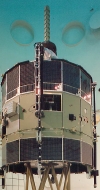
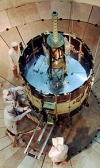

|
ISEE-3
ISEE-C
ICE
Explorer 59
#11004
1978-079A |
International Sun Earth
Explorer-3 (ISEE-3) was a satellite with the mission
to explore the interaction of the magnetic field of
the Earth and the sun. Later it was also used to explore
the comet Halley (with little results) and thus renamed
to International Comet Explorer (ICE). It was designed
and managed by GSFC and launched on August 12th
1978 on a Delta 2914 from ETR Launch Complex 17B. A
tower elevates the telemetry antenna above the spacecraft
body and provides a clear field of view for several
cosmic-ray detectors. Four wire antennas (each 49 m
long) are deployed in the spin plane as part of the
radio-wave and plasma-wave investigations. Two axial
antennas (7 m each) extend above and below the spacecraft
parallel to the spin axis to render the radio-wave measurements
three dimensional. ISEE-3 telecommunications system
includes two redundant S-band transponders:
Transponder
A (5 Watts output power):
2090.66 MHz RHCP uplink,
for command or ranging
2270.40 MHz RHCP downlink,
for telemetry or ranging
Transponder B (5 Watts
output power):
2041.95 MHz LHCP uplink, for command
2217.50 MHz LHCP downlink, for telemetry
Transmit
antenna: medium gain with dual inputs for simultaneous
right and left hand circular polarization downlink,
8 rows of 4 elements, 7 dBi, ±6° beamwidth,
multibeam, electronically steerable, four lobe, omni
directional coverage in azimuth
Receive antenna:
2042 MHz, intermediate gain, 1 row of 4 elements, 0
dBi, ±45° beamwidth
Phase coherent ranging
using fdownlink = 240/221 x
fuplink
In
2014 ISEE-3 will pass the Earth in a rather short distance
so that possibly signals from the satellite could be
received if the satellite can be reactivated. Unfortunately
NASA had none of the necessary equipment left. Thus
some enthusiasts started to rebuild the necessary hardware
and software to control the satellite. They used the
huge radio astronomy dish in Arecibo and were able to
switch the satellite back to operations. |
Aug 12th
1978 |
390 kg |
  On June
7th 2014 at 13:11 UTC Iban
EB3FRN was able to detect the signal of ISEE-3 by using
automatic doppler compensation and long integration
times. On June
7th 2014 at 13:11 UTC Iban
EB3FRN was able to detect the signal of ISEE-3 by using
automatic doppler compensation and long integration
times.  Enclosed
plots and I/Q recording were kindly provided by Iban
EB3FRN. Enclosed
plots and I/Q recording were kindly provided by Iban
EB3FRN.
|
 On
July 24th 2014 at 13:55 UTC
Paul M0EYT received ISEE-3 while it was 2.5 Mio km away
using a 1m s-band dish on 2270.406 MHz. Enclosed spectrum
plots and wterfall disgram was kindly provided by Paul
Marsh M0EYT. On
July 24th 2014 at 13:55 UTC
Paul M0EYT received ISEE-3 while it was 2.5 Mio km away
using a 1m s-band dish on 2270.406 MHz. Enclosed spectrum
plots and wterfall disgram was kindly provided by Paul
Marsh M0EYT.
|
  On
August 9th 2014 at 22:05 UTC
Fer Paglia IW1DTU received ISEE-3 on 2270.406 MHz. Enclosed
audio recording (click on left icon) of a demodulated
sideband and I/Q file (click on right icon) were kindly
provided by Fer IW1DTU. On
August 9th 2014 at 22:05 UTC
Fer Paglia IW1DTU received ISEE-3 on 2270.406 MHz. Enclosed
audio recording (click on left icon) of a demodulated
sideband and I/Q file (click on right icon) were kindly
provided by Fer IW1DTU.
|

|
Mars Global
Surveyor
(MGS)
#24648
(1996-062A) |
 Mars
Global Surveyor was launched by NASA on a Delta II rocket
and arrived at Mars on September the 12th
1997. The spectrum plot was recorded on April 14th
2006 on 8422.744 MHz and was kindly provided by www.uhf-satcom.com. Mars
Global Surveyor was launched by NASA on a Delta II rocket
and arrived at Mars on September the 12th
1997. The spectrum plot was recorded on April 14th
2006 on 8422.744 MHz and was kindly provided by www.uhf-satcom.com.
|
Nov 7th
1996 |
1030 kg |
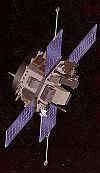

|
Advanced
Composition Explorer
ACE
Explorer 71
#24912
(1997-045A)
|
Advanced
Composition Explorer (ACE) is a NASA Explorers program
Solar and space exploration mission to study matter
comprising energetic particles from the solar wind,
the interplanetary medium, and other sources. Real-time
data from ACE is used by the NOAA Space Weather Prediction
Center to improve forecasts and warnings of solar storms.
The ACE robotic spacecraft reached its Lissajous orbit
close to the L1 Lagrangian point (which lies between
the Sun and the Earth at a distance of some 1.5 million
km from the latter) on December 12, 1997. As of 2017,
the spacecraft is still in generally good condition,
and is projected to have enough propellant to maintain
its orbit until 2024. |
Aug 25th 1997 |
752 kg |
 This
spectrum plot was recorded on August 19th
2018 at 13:52 UTC on 2278.3757 MHz and was kindly provided
by Graham Leighton G8FXB. This
spectrum plot was recorded on August 19th
2018 at 13:52 UTC on 2278.3757 MHz and was kindly provided
by Graham Leighton G8FXB.
|
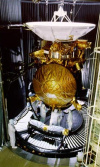
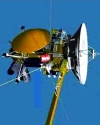
|
Cassini
#25008
(1997-061A)
&
Huygens
(1997-061C) |
The Cassini Orbiter's
mission consists of delivering a probe (called Huygens,
provided by ESA) to Titan and then remaining in orbit
around Saturn for detailed studies of the planet and
its rings and satellites. The atmospheric probe Huygens
landed on Saturn's moon Titan. |
Oct 15th 1997 |
Cassini:
2523 kg
Huygens:
319 kg |
 This recording
is a laboratory reconstruction of the sounds heard by
Huygens Atmospheric Structure Instrument (HASI), which
includes an acoustic sensor. Several sound samples,
taken at different times during the descent, are here
combined together and give a realistic reproduction
of what a traveller on board Huygens would have heard
during one minute of the descent through Titan's atmosphere
on Jan 14th 2005. Source: ESA This recording
is a laboratory reconstruction of the sounds heard by
Huygens Atmospheric Structure Instrument (HASI), which
includes an acoustic sensor. Several sound samples,
taken at different times during the descent, are here
combined together and give a realistic reproduction
of what a traveller on board Huygens would have heard
during one minute of the descent through Titan's atmosphere
on Jan 14th 2005. Source: ESA
|
 This
recording was done on July 25th
2004. Time on this recording has been compressed such
that 13 seconds corresponds to 27 seconds. Since the
frequencies of these emissions are well above the audio
frequency range, they were shifted downward by a factor
of 260. Source: NASA This
recording was done on July 25th
2004. Time on this recording has been compressed such
that 13 seconds corresponds to 27 seconds. Since the
frequencies of these emissions are well above the audio
frequency range, they were shifted downward by a factor
of 260. Source: NASA
|
  Paul
M0EYT received Cassini on May 29th
2017 at 00:17h UTC. He received Cassini at 8429.926
MHz. Audio recording of the carrier and spectrum plot
kindly provided by www.uhf-satcom.com. Paul
M0EYT received Cassini on May 29th
2017 at 00:17h UTC. He received Cassini at 8429.926
MHz. Audio recording of the carrier and spectrum plot
kindly provided by www.uhf-satcom.com.
|
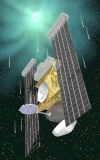
|
Stardust/NExT
#25618
(1999-003A) |
The primary objective
of the Discovery class Stardust mission was to fly by
the comet P/Wild 2 and collect samples of dust and volatiles
from the coma of the comet and then bring them back
to Earth. This was fully accomplished and furthermore
the mission was extended to a flyby of comet Tempel
1. Thus the name of the mission was also extended to
The New Exploration of Tempel 1 (NExT). Also this part
of the mission was successful. |
Feb 7th 1999 |
300 kg |
 Enclosed
sounds were recorded on February 14th
2011 when Stardust flew through a cloud of debris surrounding
comet Tempel 1 and such particles hi an instrument on
the protective shield of Stardust. Link kindly provided
by Christian Schwarze. Recording is a courtesy of NASA/JPL. Enclosed
sounds were recorded on February 14th
2011 when Stardust flew through a cloud of debris surrounding
comet Tempel 1 and such particles hi an instrument on
the protective shield of Stardust. Link kindly provided
by Christian Schwarze. Recording is a courtesy of NASA/JPL.
|
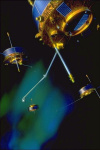
|
2000 Cluster
2
FM6
Salsa
#26411
(2000-041B) |
The Cluster II spacecraft,
FM6 (Salsa), was launched together with FM7 (Samba).
The four similar spacecraft of the Cluster II mission
are part of ESA's and NASA's Solar-Terrestrial Science
Program (STSP). |
Jul 16th 2000 |
550 kg |
  Earth
AKR (Auroral Kilometric Radiation) recorded in stereo
by the Cluster 2 spacecraft. The four Cluster II WBD
(wideband) instruments were designed and built at The
University of Iowa through funding provided by NASA's
Goddard Space Flight Center. Provided by Don Gurnett.
Courtesy of NASA and the University of Iowa. Earth
AKR (Auroral Kilometric Radiation) recorded in stereo
by the Cluster 2 spacecraft. The four Cluster II WBD
(wideband) instruments were designed and built at The
University of Iowa through funding provided by NASA's
Goddard Space Flight Center. Provided by Don Gurnett.
Courtesy of NASA and the University of Iowa.
|
  Earth
whistlers recorded in stereo by the Cluster 2 spacecraft.
The aim of the Cluster mission is to study small-scale
structures of the magentosphere and its environment
in three dimensions. To achieve this, Cluster is constituted
of four identical spacecrafts which fly in a tetrahedral
configuration. Provided by Don Gurnett. Courtesy of
NASA and the University of Iowa. Earth
whistlers recorded in stereo by the Cluster 2 spacecraft.
The aim of the Cluster mission is to study small-scale
structures of the magentosphere and its environment
in three dimensions. To achieve this, Cluster is constituted
of four identical spacecrafts which fly in a tetrahedral
configuration. Provided by Don Gurnett. Courtesy of
NASA and the University of Iowa.
|

|
2001
Mars Odyssey
#26734
(2001-014A) |
 2001
Mars Odyssey was launched on a Delta II rocket from
Cape Canaveral. The spectrum plot was recorded on April
11th 2006 and was kindly provided
by www.uhf-satcom.com. 2001
Mars Odyssey was launched on a Delta II rocket from
Cape Canaveral. The spectrum plot was recorded on April
11th 2006 and was kindly provided
by www.uhf-satcom.com.
|
Apr 7th
2001 |
725 kg |
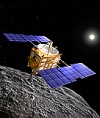


|
Hayabusa
Muses-C
#27809
(2003-019C) |
 The primary
scientific objective of the Hayabusa (Muses-C) mission
is to collect The primary
scientific objective of the Hayabusa (Muses-C) mission
is to collect  a
surface sample of material from the small (550 x 180
meter) asteroid 25143 Itokawa (1998 SF36) and return
the sample to Earth for analysis. Communications are
via X- and S-band low gain antennas and the high gain
dish antenna (X-band) with a transmitted power of 20
W. Two solar panel wings with a total array area of
12 square meters protrude from the side and a 1.5 m
diameter high-gain parabolic antenna is mounted on top
of the aircraft. On June 8th
2010 at 20:16 UTC the X-band downlink signal (8408.217
MHz) of Hayabusa was received by F5PL. The recording
was kindly provided by Bertrand F5PL. a
surface sample of material from the small (550 x 180
meter) asteroid 25143 Itokawa (1998 SF36) and return
the sample to Earth for analysis. Communications are
via X- and S-band low gain antennas and the high gain
dish antenna (X-band) with a transmitted power of 20
W. Two solar panel wings with a total array area of
12 square meters protrude from the side and a 1.5 m
diameter high-gain parabolic antenna is mounted on top
of the aircraft. On June 8th
2010 at 20:16 UTC the X-band downlink signal (8408.217
MHz) of Hayabusa was received by F5PL. The recording
was kindly provided by Bertrand F5PL.
|
May 9th
2003 |
415 kg |
After a 7 years mission
Hayabusa returned to Earth's and burned up during re-entry
in its atmosphere over Australia on June 13th
2010 around 14:00 UTC. Three hours before re-entry the
return capsule was successfully ejected and landed in
the Woomera prohibited area in the Australian outback
where it was retrieved on June 14th
2010. |
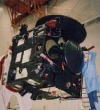
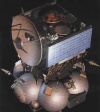

|
Mars Express
#27816
(2003-022A) |
  Mars
Express was launched by the European Space Agency on
a Soyuz-Fregat from the Baikonur Cosmodrome. It included
a lander called Beagle 2. Mars
Express was launched by the European Space Agency on
a Soyuz-Fregat from the Baikonur Cosmodrome. It included
a lander called Beagle 2.
It features the following communication
downlinks:
X-band: 8420.43207 MHz (61.27 dBW)
S-band: 2296.481481 MHz (37.53dBW)
The used high gain antenna is a 1.6m
centered parabolish dish which provides 39.3 dBi gain
at X-band and 27.3 dBi at S-band.
The sound file as well as the spectrum
plot were recorded on April 11th
2006 and were kindly provided by www.uhf-satcom.com. |
Jun 2nd 2003 |
1120 kg |

|
Spitzer
Space
Telescope
#27871
(2003-038A) |
 Launched
by NASA on a Delta rocket from Cape Canaveral. It is
a space-borne, cryogenically-cooled infrared observatory
capable of studying objects ranging from our Solar System
to the distant reaches of the Universe. The spectrum
plot was recorded at 8413.626490 MHz on April 23rd
2006 and was kindly provided by www.uhf-satcom.com. Launched
by NASA on a Delta rocket from Cape Canaveral. It is
a space-borne, cryogenically-cooled infrared observatory
capable of studying objects ranging from our Solar System
to the distant reaches of the Universe. The spectrum
plot was recorded at 8413.626490 MHz on April 23rd
2006 and was kindly provided by www.uhf-satcom.com.
|
Aug 25th 2003 |
950 kg |
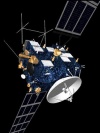
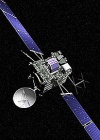
|
Rosetta
#28169
(2004-006A) |
 Rosetta
is is en-route to Comet 67 P/Churyumov- Gerasimenko.
It transmits on 8421.790123 MHz. The spectrum plot was
recorded on May 4th 2006 and
was kindly provided by www.uhf-satcom.com. Rosetta
is is en-route to Comet 67 P/Churyumov- Gerasimenko.
It transmits on 8421.790123 MHz. The spectrum plot was
recorded on May 4th 2006 and
was kindly provided by www.uhf-satcom.com.
|
Mar 2nd 2004 |
810 kg |
 Michael
OH2AUE built an 8.4 GHz receiver from junk and received
Rosetta using his club station 4 m dish. He webcasted
the event, a video of the shack and the BPSK carrier
audio to other interested people. The enclosed audio
recording was kindly provided by Michael Fletcher OH2AUE. Michael
OH2AUE built an 8.4 GHz receiver from junk and received
Rosetta using his club station 4 m dish. He webcasted
the event, a video of the shack and the BPSK carrier
audio to other interested people. The enclosed audio
recording was kindly provided by Michael Fletcher OH2AUE.
|
 Paul M0EYT
received Rosetta at 8421.112 MHz on August 29th
2010 at 14:00 UTC when it was 361 Paul M0EYT
received Rosetta at 8421.112 MHz on August 29th
2010 at 14:00 UTC when it was 361  million
miles or 32.3 minutes light time away. You cannot really
hear the signal in the audio file enclosed but if you
run an fft over time (see the picture) you can clearly
identify the carrier including its doppler shift. Recording
kindly provided by www.uhf-satcom.com. million
miles or 32.3 minutes light time away. You cannot really
hear the signal in the audio file enclosed but if you
run an fft over time (see the picture) you can clearly
identify the carrier including its doppler shift. Recording
kindly provided by www.uhf-satcom.com.
|
 Rosetta’s Plasma
Consortium (RPC) has uncovered oscillations in the magnetic
field in the environment of comet 67P/Churyumov-Gerasimenko.
It is like a song at 40-50 millihertz, far below human
hearing, which typically picks up sound between 20 Hz
and 20 kHz. To make the music audible to the human ear,
the frequencies have been increased by Manuel Senfft
in this recording also called "A Singing Comet".
Recording kindly provided by "TU
Braunschweig / IGFP / Manuel Senfft". Rosetta’s Plasma
Consortium (RPC) has uncovered oscillations in the magnetic
field in the environment of comet 67P/Churyumov-Gerasimenko.
It is like a song at 40-50 millihertz, far below human
hearing, which typically picks up sound between 20 Hz
and 20 kHz. To make the music audible to the human ear,
the frequencies have been increased by Manuel Senfft
in this recording also called "A Singing Comet".
Recording kindly provided by "TU
Braunschweig / IGFP / Manuel Senfft".
|
 Paul
M0EYT received Rosetta on September 30th
2016 at 11:19h UTC when it intentionally was crashed
on the surface of comet 67P/Tschurjumov-Gerassimenko.
At that time the comet was at a distance of 720 Mio
km from Earth. Paul received Rosetta at 8421.42217 MHz.
Spectrum plot kindly provided by www.uhf-satcom.com. Paul
M0EYT received Rosetta on September 30th
2016 at 11:19h UTC when it intentionally was crashed
on the surface of comet 67P/Tschurjumov-Gerassimenko.
At that time the comet was at a distance of 720 Mio
km from Earth. Paul received Rosetta at 8421.42217 MHz.
Spectrum plot kindly provided by www.uhf-satcom.com.
|
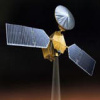
|
Mars
Reconnaissance
Orbiter (MRO)
#28788
(2005-029A) |
  Mars
Reconnaissance Orbiter (MRO) was launched by NASA on
an Atlas V-401 from Cape Canaveral. MRO arrived at Mars
on March 10th 2006. The sound
file as well as the spectrum plot were recorded on December
20th 2005 when the spacecraft
was 53258740 miles away from Earth. They were kindly
provided by www.uhf-satcom.com. Mars
Reconnaissance Orbiter (MRO) was launched by NASA on
an Atlas V-401 from Cape Canaveral. MRO arrived at Mars
on March 10th 2006. The sound
file as well as the spectrum plot were recorded on December
20th 2005 when the spacecraft
was 53258740 miles away from Earth. They were kindly
provided by www.uhf-satcom.com.
|
Aug 12th 2005 |
2180 kg |
 The signal
from MRO, while it was 356 Mio km away from Earth, The signal
from MRO, while it was 356 Mio km away from Earth,  was
received at 8439.44 MHz on May 23rd
2019 at 12:50 UTC by DF2MZ. The fast sweeping sound
is an artifact from his doppler compensation at 1s intervals
and MRO's high doppler rate. The slower wobble, which
is visible in the plot, results from uplink modulation
by the ground station. Spectrum plot and sound file
kindly provided by Edgar J. Kaiser DF2MZ. was
received at 8439.44 MHz on May 23rd
2019 at 12:50 UTC by DF2MZ. The fast sweeping sound
is an artifact from his doppler compensation at 1s intervals
and MRO's high doppler rate. The slower wobble, which
is visible in the plot, results from uplink modulation
by the ground station. Spectrum plot and sound file
kindly provided by Edgar J. Kaiser DF2MZ.
|

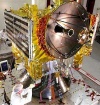
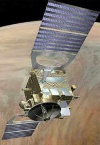
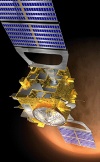
|
Venus Express
#28901
(2005-045A) |
  Venus
Express was launched by the European Space Agency on
a Soyuz-Fregat from the Baikonur Cosmodrome. It transmits
a tracking / telemetry beacon on DSN channel 17 which
is 8419.074074 MHz. The data enclosed was recorded when
the probe was 4.17 million miles away. Record and spectrum
plot were kindly provided by www.uhf-satcom.com. Venus
Express was launched by the European Space Agency on
a Soyuz-Fregat from the Baikonur Cosmodrome. It transmits
a tracking / telemetry beacon on DSN channel 17 which
is 8419.074074 MHz. The data enclosed was recorded when
the probe was 4.17 million miles away. Record and spectrum
plot were kindly provided by www.uhf-satcom.com.
|
Nov 9th 2005 |
1270 kg |
On January 25th
2010 11:10 UTC Juan Daniel Gallego was able to use the
40m dish antenna of OAN in Yebes, Spain to receive Venus
Express using a  Perseus
Software Defined receiver. At the time of reception
Venus Express was 256 million km away ! After converting
the 8.4 GHz signal down to about 3.1 MHz the beacon
signal was finally demodulated using USB detection of
the Perseus SDR receiver with an IF filter BW of 2.4
kHz. A description of the setup can be found when clicking
on the icon of the dish antenna. Perseus
Software Defined receiver. At the time of reception
Venus Express was 256 million km away ! After converting
the 8.4 GHz signal down to about 3.1 MHz the beacon
signal was finally demodulated using USB detection of
the Perseus SDR receiver with an IF filter BW of 2.4
kHz. A description of the setup can be found when clicking
on the icon of the dish antenna.
  In
the first recording you can hear the carrier of the
beacon (changing pitch over time due to doppler effect). In
the first recording you can hear the carrier of the
beacon (changing pitch over time due to doppler effect).
  In
the second recording the upper sideband of the signal
carrying the downlink data was demodulated. In
the second recording the upper sideband of the signal
carrying the downlink data was demodulated.
Many thanks to Juan Daniel Gallego
for kindly providing the recordings and screenshots. |

|
New Horizons
Pluto
Charon
#28928
(2006-001A) |
 New Horizons
Pluto Charon was launched by NASA on an Atlas V from
Cape Canaveral and is en-route to Pluto. It transmits
on 8437.894737 MHz and 8438.181818 MHz. The spectrum
plot was recorded on April 12th
2006 when it was 64509465 miles away from earth. It
was kindly provided by www.uhf-satcom.com. New Horizons
Pluto Charon was launched by NASA on an Atlas V from
Cape Canaveral and is en-route to Pluto. It transmits
on 8437.894737 MHz and 8438.181818 MHz. The spectrum
plot was recorded on April 12th
2006 when it was 64509465 miles away from earth. It
was kindly provided by www.uhf-satcom.com.
|
Jan 19th
2006 |
393 kg |
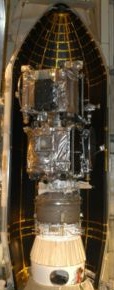
|
Stereo
A
#29510
(2006-047A) |
Stereo A
& B (Solar TErrestrial RElations Observatory) were
jointly launched by NASA aboard a single Boeing Delta
II rocket from Cape Canaveral. On the picture to the
left you can see them both while getting assembled in
the fairing. They are providing 3D images of the sun. |
Oct
25th
2006 |
642
kg |
  Stereo
A is lagging Stereo B and transmits on 8443.5185 MHz.
The audio recording and the spectrum plot were kindly
provided by Paul Marsh M0EYT from www.uhf-satcom.com. Stereo
A is lagging Stereo B and transmits on 8443.5185 MHz.
The audio recording and the spectrum plot were kindly
provided by Paul Marsh M0EYT from www.uhf-satcom.com.
|
 This signal
of Stereo A while being much further away from Earth
and thus much weaker was recorded on September 1st
2010 by Paul Marsh M0EYT. This signal
of Stereo A while being much further away from Earth
and thus much weaker was recorded on September 1st
2010 by Paul Marsh M0EYT.
|
Graham Leighton G8FXB
received and decoded Stereo-A on 8455.5088 MHz while
it was 1.5 Mio km away from Earth. He was using a 1.2m
offset dish, conical feed, squeezed pipe polarizer and
a 4 stage ultro low noise amplifier. Attached screen-shots
of his SDR receiver and a decoded animation of the down-link
pictures were kindly provided by Graham G8FXB.
  
|
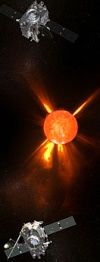
|
Stereo
B
#29511
(2006-047B) |
 Stereo
A & B (Solar TErrestrial RElations Observatory)
were jointly launched by NASA and are providing 3D images
of the sun by observing the sun from different positions
/ angles. They are both in a heliocentric orbit. The
date downlink rate is 720 kBit/sec. Stereo
A & B (Solar TErrestrial RElations Observatory)
were jointly launched by NASA and are providing 3D images
of the sun by observing the sun from different positions
/ angles. They are both in a heliocentric orbit. The
date downlink rate is 720 kBit/sec.
|
Oct
25th
2006 |
642
kg |
  Stereo
B is leading Stereo A and transmits on 8446.2345 MHz.
The audio recording and the spectrum plot were kindly
provided by Paul Marsh M0EYT from www.uhf-satcom.com. Stereo
B is leading Stereo A and transmits on 8446.2345 MHz.
The audio recording and the spectrum plot were kindly
provided by Paul Marsh M0EYT from www.uhf-satcom.com.
|
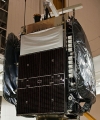
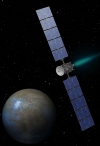
|
DAWN
#32249
(2007-043A) |
Dawn
is a mission designed to rendezvous and orbit the asteroids
4 Vesta and 1 Ceres. The scientific objectives of the
mission are to characterize the asteroids' internal
structure, density, shape, size, composition and mass
and to return data on surface morphology, cratering,
and magnetism. Uplink
data rates range from 7.8 b/s to 2.0 kb/s and downlink
rates from 10 b/s to 124 kb/s. |
Sept
27th
2007 |
725
kg |
  On
May 7th 2015 az 07:26 UTC Paul
M0EYT received the DAWN downlink on 8435.9723 MHz. At
this time DAWN had a distance to Earth of 384308500km.
The audio recording and the spectrum plot were kindly
provided by Paul Marsh M0EYT from www.uhf-satcom.com. On
May 7th 2015 az 07:26 UTC Paul
M0EYT received the DAWN downlink on 8435.9723 MHz. At
this time DAWN had a distance to Earth of 384308500km.
The audio recording and the spectrum plot were kindly
provided by Paul Marsh M0EYT from www.uhf-satcom.com.
|
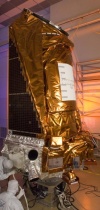
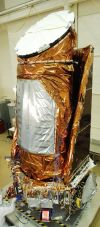
|
Kepler
Discovery 10
#34380
(2009-011A) |
NASA's Kepler Mission
is to survey our region of the Milky Way galaxy to discover
hundreds of Earth-size and smaller planets in or near
the habitable zone and determine how many of the billions
of stars in our galaxy have such planets. It includes
a 0.95m aperture differential photometer with a 105°
FOV. Kepler was launched on March 6th
2009 from Cape Canaveral/Florida on a Delta rocket into
an Earth-trailing heliocentric orbit. |
Mar 6th
2009 |
1000 kg |
Kepler uses the following
communication links:
- Uplink X-band: 7.8125 bps
up to 2 kbps
- Downlink X-band: 10 bps up to 16
kbps, antenna gain is 6.5dB, transmit power is 14dBW,
activated twice a week for commanding, health and status.
- Downlink Ka-band: up to 4.33125 Mbps, antenna gain
is 46.6dB, transmit power is 14dBW, activated once a
month for science data download. |
 The
X-band downlink was received by Paul Marsh on March
8th 2009. The FFT was received in a 5KHz b/w of the
8424.476 MHz downlink at 19:18 UTC on March 8th
2009. The
X-band downlink was received by Paul Marsh on March
8th 2009. The FFT was received in a 5KHz b/w of the
8424.476 MHz downlink at 19:18 UTC on March 8th
2009.
|
 The
Ka-band downlink was received by Paul Marsh on April
29th 2009 who had put together a 32GHz down converter
from commonly available parts and then used a SDR-14
FFT receiver from RF-Space. The
Ka-band downlink was received by Paul Marsh on April
29th 2009 who had put together a 32GHz down converter
from commonly available parts and then used a SDR-14
FFT receiver from RF-Space.
 The
first FFT was received in a 5KHz b/w of the 32166.1711
MHz downlink at 19:41UTC on April 29th 2009 while the
space-probe was about 3226045 Miles away from Earth. The
first FFT was received in a 5KHz b/w of the 32166.1711
MHz downlink at 19:41UTC on April 29th 2009 while the
space-probe was about 3226045 Miles away from Earth.
 The
second FFT was received in a 3KHz b/w of the 32166.1653
MHz downlink at 21:27UTC on April 29th 2009 while the
space-probe was about 3226445 Miles away from Earth. The
second FFT was received in a 3KHz b/w of the 32166.1653
MHz downlink at 21:27UTC on April 29th 2009 while the
space-probe was about 3226445 Miles away from Earth.
Note: The FFT shows the drift due to doppler shift and
a slight wobble in the carrier which is caused by Paul's
receiver: the GPS reference oscillators 10MHz output
is being multiplied 3420 times to generate the 34.2GHz
local oscillator. Therefore a very slight wobble in
the GPS control loop is strongly amplified.
|
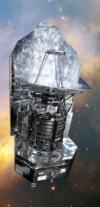
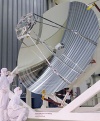
|
Herschel
(FIRST)
#34937
(2009-026A) |
Herschel Space Observatory
carries the largest space telescope ever launched before.
Herschel was launched together with Planck on an
Ariane 5 rocket from Kourou / French Guiana. From
a point in space called the 2nd Lagrangian Point (or
L2), its 3.5-m diameter mirror will collect long-wavelength
infrared radiation from some of the coolest and most
distant objects in the Universe. |
May
14th 2009 |
3300kg |
 On
May 15th 2009 the distance
from Herschel to the Earth was only ~170,000 Miles.
Signals from Herschel were received at 8468.454MHz on
May 15th 2009 at 22:25 UTC
by Paul Marsh M0YET. The first FFT plot shows the tail
end of a coherent On
May 15th 2009 the distance
from Herschel to the Earth was only ~170,000 Miles.
Signals from Herschel were received at 8468.454MHz on
May 15th 2009 at 22:25 UTC
by Paul Marsh M0YET. The first FFT plot shows the tail
end of a coherent  locking
cycle. On the second plot sidebands carrying data can
clearly be seen. Waterfall diagrams kindly provided
by Paul M0YET. locking
cycle. On the second plot sidebands carrying data can
clearly be seen. Waterfall diagrams kindly provided
by Paul M0YET.
|
 Paul
Marsh received Herschel again on May 2nd
2013 at 22:53 UTC on 8468.469 MHz. Waterfall diagrams
kindly provided by Paul M0YET. Paul
Marsh received Herschel again on May 2nd
2013 at 22:53 UTC on 8468.469 MHz. Waterfall diagrams
kindly provided by Paul M0YET.
|
The Herschel astronomical
observatory satellite was closed down on April 29th
2013 as the last liquid helium for the cooling system
evaporated. |
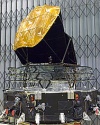
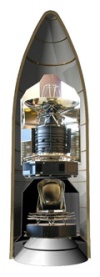
|
Planck
#34938
(2009-026B) |
Planck was launched together
with Herschel on an Ariane 5 rocket from Kourou
/ French Guiana. In the lower picture on the left you
can see it is located below Herschel. The Planck satellite
will observe the cosmic microwave background radiation
(CMB). This is the radiation released into the Universe
by the Big Bang about 14 thousand million years ago.
Planck carries a telescope with an effective aperture
of 1.5 m that feeds microwave radiation to two instruments:
1.) High Frequency Instrument (HFI) which is an array
of 52 bolometric detectors and will image the sky at
six frequencies between 100 GHz and 857 GHz.
2.)
Low Frequency Instrument (LFI) which is an array of
22 tuned radio receivers and images the sky at three
frequencies between 30 GHz and 70 GHz.
|
May
14th 2009 |
1800
kg |
Downlink frequency was
8468.454MHz. The FFT's below are from the IF frequency,
simply add 8GHz to get the receive frequency. The distance
to the probe was only ~170,000 Miles.
 The
first FFT shows the tail end of a coherent locking cycle. The
first FFT shows the tail end of a coherent locking cycle.
 In
the second FFT plot the data sidebands can be seen. In
the second FFT plot the data sidebands can be seen.
Signals received on May 15th 2009
at 22:04 UTC by Paul Marsh M0YET. |
  Paul M0EYT
received Planck again on October 21st
2013, two days before Planck was planned to be shutdown.
Enclosed spectrum plots Paul M0EYT
received Planck again on October 21st
2013, two days before Planck was planned to be shutdown.
Enclosed spectrum plots  and
recording were kindly provided by Paul Marsh M0EYT. and
recording were kindly provided by Paul Marsh M0EYT.
|
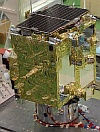
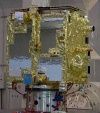
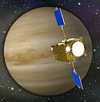
|
Venus
Climate
Orbiter (VCO)
PLANET-C
AKATSUKI
#36576
(2010-020D) |
PLANET-C is Japan's first
Venus probe, designed to study the dynamics of the atmosphere
and to establish the meteorology of Venus. Venus Climate
Orbiter will be built and launched by JAXA into an elliptical
orbit around Venus with a period of 30 hours. The target
launch date is May 17th 2010
from JAXA Tanegashima Space Centre in Japan. Venus'
surface is invisible under a thick layer of sulfuric
acid clouds and thus Planet-C will image Venus at different
wavelengths (lightning and airglow in visible light,
cloud temperature map in mid-infrared, chemical composition
at cloud top in ultraviolet, ground surface in near-infrared,
and lower atmosphere in near-infrared). It will also
include an ultra-stable oscillator for radio science
experiments. Together with Planet-C as the primary payload
there will be 5 secondary payloads launched: IKAROS,
UNISEC-1 and deployed together in a J_POD module WASEDA-SAT2,
KSAT and Negai*.
 260214
people around the world did participate in the "AKATSUKI
message campaign" and registered their names to
be printed on a special aluminium plate attached to
the aircraft. The confirmation image I received can
be seen when clicking on the icon to the right. 260214
people around the world did participate in the "AKATSUKI
message campaign" and registered their names to
be printed on a special aluminium plate attached to
the aircraft. The confirmation image I received can
be seen when clicking on the icon to the right. |
May
20th 2010 |
500
kg |
  On May
22nd 2010 Bertrand Pinel F5PL
received Planet-C on 8410.8039 MHz with a . Recording
and spectrum plot kindly provided by Bertrand F5PL. On May
22nd 2010 Bertrand Pinel F5PL
received Planet-C on 8410.8039 MHz with a . Recording
and spectrum plot kindly provided by Bertrand F5PL.
|
  The X-Band
signal from Akatsuki was received on 8411.28075 MHz
on July 29th 2018 at 16:30
UTC by Paul M0EYT. The X-Band
signal from Akatsuki was received on 8411.28075 MHz
on July 29th 2018 at 16:30
UTC by Paul M0EYT. Recording and spectrum plots kindly provided by Paul
Marsh M0EYT.
Recording and spectrum plots kindly provided by Paul
Marsh M0EYT.
|





|
IKAROS
#36577
(2010-020E) |
 IKAROS
(Interplanetary Kite-craft Accelerated by Radiation
Of the Sun) was launched by JAXA together with PLANET-C
and four other secondary payloads. This solar space
kite satellite is also heading towards Venus and is
expected to enter Venus' orbit after the 6 month journey. IKAROS
(Interplanetary Kite-craft Accelerated by Radiation
Of the Sun) was launched by JAXA together with PLANET-C
and four other secondary payloads. This solar space
kite satellite is also heading towards Venus and is
expected to enter Venus' orbit after the 6 month journey.
 IKAROS
is the first fuel-free, solar-powered sail craft to
enter deep space “employing both photon propulsion and
thin film solar power generation” during its flight. The
sail of the IKAROS is a square membrane with a diagonal
distance of 20 meters and only 0.0075 mm thin. Paul
Marsh received IKAROS on May 23rd
2010 on 8431.1752 MHz. Enclosed please see the spectrum
plots he made. IKAROS
is the first fuel-free, solar-powered sail craft to
enter deep space “employing both photon propulsion and
thin film solar power generation” during its flight. The
sail of the IKAROS is a square membrane with a diagonal
distance of 20 meters and only 0.0075 mm thin. Paul
Marsh received IKAROS on May 23rd
2010 on 8431.1752 MHz. Enclosed please see the spectrum
plots he made.
|
May
20th 2010 |
315
kg |
  On May
25th 2010 around 20:20 UTC
also Bertrand F5PL received IKAROS at 8431.171 MHz (DSN
channel number 26) with a Signal strength of about +2
dB @2000 Hz BW. You can hear the signal in enclosed
audio recording. On May
25th 2010 around 20:20 UTC
also Bertrand F5PL received IKAROS at 8431.171 MHz (DSN
channel number 26) with a Signal strength of about +2
dB @2000 Hz BW. You can hear the signal in enclosed
audio recording.  His
antenna is an automated 10 foot dish with a cassegrain
feed and an LNA with 0.5 dB NF. Bertrand suspects a
problem with the frequency stability of the transmitter
of IKAROS. It is wobbling with a period of about 2 secs
as you can see in enclosed frequency spectrum plots
which Bertrand F5PL kindly provided. His
antenna is an automated 10 foot dish with a cassegrain
feed and an LNA with 0.5 dB NF. Bertrand suspects a
problem with the frequency stability of the transmitter
of IKAROS. It is wobbling with a period of about 2 secs
as you can see in enclosed frequency spectrum plots
which Bertrand F5PL kindly provided.
|
   On May
28th 2010 at 20:46 and 21:30
UTC Bertrand received IKAROS again and made enclosed
specturm plots. At this time IKAROS was using its omni
antenna and its RF power was 7 W. On May
28th 2010 at 20:46 and 21:30
UTC Bertrand received IKAROS again and made enclosed
specturm plots. At this time IKAROS was using its omni
antenna and its RF power was 7 W.  The
wobble frequency of the transmitter changed to about
4.2 secs and his new theory is that it is related to
the spin frequency of the probe. Thanks to F5PL for
kindly providing the recordings and plots. The
wobble frequency of the transmitter changed to about
4.2 secs and his new theory is that it is related to
the spin frequency of the probe. Thanks to F5PL for
kindly providing the recordings and plots.
|
Despite of the increasing
distance of IKAROS from  Earth
Bertrand received the probe also on June 4th
2010 and provided enclosed very nice spectrum plot.
It shows the wobbling of the signal very clearly. Thanks
to F5PL for kindly providing the plots. Earth
Bertrand received the probe also on June 4th
2010 and provided enclosed very nice spectrum plot.
It shows the wobbling of the signal very clearly. Thanks
to F5PL for kindly providing the plots. |
 Bertrand
Pinel F5PL and Jean-Jacques Maintoux F1EHN prepared
enclosed very nice analysis of the wobbling downlink
signal of IKAROS. Many thanks to F5PL for providing
this document. Bertrand
Pinel F5PL and Jean-Jacques Maintoux F1EHN prepared
enclosed very nice analysis of the wobbling downlink
signal of IKAROS. Many thanks to F5PL for providing
this document.
|
On June 15th
2010, IKAROS released a spring-loaded detachable camera
module, a cylinder about six centimeters in diameter,
which snapped a series of pictures of the deployed 14-by-14
meter solar sail of the larger craft as it drifted away
(see pictures to the left). |
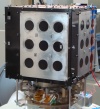
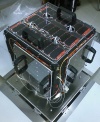
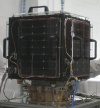
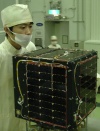
|
UNITEC-1
#36578
(2010-020F) |
UNITEC-1 (UNISEC Technology
Experiment Carrier -1) is the world's first deep space
satellite jointly developed by more than 20 universities.
UNISEC stands for University Space Engineering Consortium.
UNITEC-1 was launched together with PLANET-C and four
other secondary payloads towards Venus. UNITEC-1 will
be the last satellite to separate from the H-IIA F17
launcher. One of the 3 missions of this nanosatellite
is to provide the amateur radio community a challenge
to receive faint deep space signals. Unitec-1 will transmit
at 5840.000 MHz using the callsign JQ1ZUN. Its transmit
power is 4.8W per each of the two microstrip patch antennas,
thus in total 9.6W. The satellite's downlink schedule
is a 6 hour cycle with mainly pauses and the following
transmissions:
96% of TX time: CW in 1bps
4%
of TX time: AFSK/FM 1200bps packet radio
Six universities
are running experiments on UNITEC-1 which provide the
payload data of the AFSK transmission. The transmission
format is specified as "10M0F2D" and the bandwidth
will be 20 MHz. |
May
20th 2010 |
15
kg |
  Before
UNITEC-1 was launched the communication system was tested.
Enclosed audio file of the CW test transmission was
recorded on May 9th 2010. The
second audio file documents an FSK test transmission
and was recorded on May 10th
2010. The recordings were kindly provided by UNISEC.
Special thanks to Naomi Kurahara JE6GXN. Before
UNITEC-1 was launched the communication system was tested.
Enclosed audio file of the CW test transmission was
recorded on May 9th 2010. The
second audio file documents an FSK test transmission
and was recorded on May 10th
2010. The recordings were kindly provided by UNISEC.
Special thanks to Naomi Kurahara JE6GXN.
|
  After
the successful launch on May 21st
2010 first CW and FSK signals were received on 5839.91
MHz during the first pass over Japan around 16:15h JST.
Unfortunately soon after the transmitter of Unitec-1
stopped working. The recordings were kindly provided
by UNISEC. Special thanks to Naomi Kurahara JE6GXN. After
the successful launch on May 21st
2010 first CW and FSK signals were received on 5839.91
MHz during the first pass over Japan around 16:15h JST.
Unfortunately soon after the transmitter of Unitec-1
stopped working. The recordings were kindly provided
by UNISEC. Special thanks to Naomi Kurahara JE6GXN.
|
 On May
21th 2010 JA4BLC copied the
signal of Unitec-1 at 15:41:49 UTC for 15 seconds. On May
21th 2010 JA4BLC copied the
signal of Unitec-1 at 15:41:49 UTC for 15 seconds.  The
frequency was 5839.905 MHz. He used a 6m parabolic dish
(10mm mesh) with a modified W2IMU horn. Enclosed audio
file and spectrum plot was kindly provided by Yoshiro
JA4BLC. The
frequency was 5839.905 MHz. He used a 6m parabolic dish
(10mm mesh) with a modified W2IMU horn. Enclosed audio
file and spectrum plot was kindly provided by Yoshiro
JA4BLC.
|
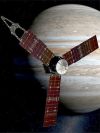
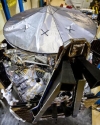
|
JUNO
New Frontiers 2
#37773
(2011-040A) |
JUNO (JUpiter Near-polar
Orbiter) was built by NASA and launched on an Atlas
V551 (AV-029) from Cape Canaveral to its 5 years journey
to Jupiter. Starting 2016 it will orbit Jupiter 33 times
during one Earth year before its mission will end with
a de-orbit into Jupiter.
Juno is expected to give
scientists a never-before-seen look behind Jupiter's
clouds
JUNO carries a X-band (8.404 GHz) and Ka-band
(32.083 GHz) communication links with multiple antennas
(LGA fore, LGA aft, LGA totoidal MGA, HGA). RF power
at X-Band is 14 dBW and at Ka-Band its 4 dBW. |
Aug.
5th
2011 |
1500
kg |
  On August
9th 2011 around 07:50 UTC Paul
M0EYT received Juno while it was already 1.1 Mio km
away from Earth. You have to add 8 GHz to the frequency
displayed in enclosed spectrum plot to get the actual
receive frequency. The audio file is from the same recording.
Both were kindly provided by Paul Marsh M0EYT. On August
9th 2011 around 07:50 UTC Paul
M0EYT received Juno while it was already 1.1 Mio km
away from Earth. You have to add 8 GHz to the frequency
displayed in enclosed spectrum plot to get the actual
receive frequency. The audio file is from the same recording.
Both were kindly provided by Paul Marsh M0EYT.
|
 On
May 10th 2013 at 20:46 UTC
Paul M0EYT received Juno and recorded enclosed spectrum
plot. At that time Juno was 4.45 minutes light time
away from Earth. Spectrum plot kindly provided by Paul
Marsh M0EYT. On
May 10th 2013 at 20:46 UTC
Paul M0EYT received Juno and recorded enclosed spectrum
plot. At that time Juno was 4.45 minutes light time
away from Earth. Spectrum plot kindly provided by Paul
Marsh M0EYT.
|
  On October
9th JUNO made a flyby of Earth
and came very close (approx 500km). Two days before,
on June 7th 2013 at 14:59 UTC,
Paul M0EYT recorded it on 8404.423 MHz. The signal was
already very strong as can be heard on enclosed recording
and seen on the associated spectrum plot. Both were
kindly provided by Paul Marsh M0EYT. On October
9th JUNO made a flyby of Earth
and came very close (approx 500km). Two days before,
on June 7th 2013 at 14:59 UTC,
Paul M0EYT recorded it on 8404.423 MHz. The signal was
already very strong as can be heard on enclosed recording
and seen on the associated spectrum plot. Both were
kindly provided by Paul Marsh M0EYT.
|
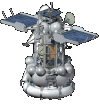 |
Phobos-Grunt
Fobos-Grunt
PHOBOS-GR
#37872
(2011-065A) |
Phobos-Grunt
is a Russian mission designed to land on the martian
moon Phobos and return a sample to Earth. It was launched
on November 8th 2011 at 20:16
UTC on a Zenit 2SB41.1 rocket from the Baikonur Cosmodrome
in Kazakhstan into an elliptical Earth orbit. Unfortunately
the spacecraft did not perform its scheduled burn to
leave the Earth orbit and begin its trajectory to Mars.
The downlink frequencies are:
8414.6328 MHz of the
transfer module
8428.7316 MHz of the return module |
Nov.
8th
2011 |
730
kg |
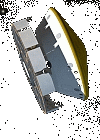


|
Mars
Sciency Laboratory
MSL
Curiosity
#37936
(2011-070A)
|
The
Mars Science Laboratory (MSL) was launched on an ATLAS
V (541) from Cape Canaveral USA. The main part of MSL
is a large rover nicknamed Curiosity with the objective
of exploring the martian environment as a former or
current habitat for life. The mission is planned to
operate on Mars over at least a full martian year (687
Earth days). The Mars rover is powered by nuclear energy.
Curiosity reached Mars after an 8 month journey and
landed successfully on August 7th
2012 at 05:32 GMT.
Here is the x-band
downlink information of MSL:
Downlink frequency:
8401.419752 MHz
Transmit power: 69.2 dBm
Ground
G/T Required 54.7 dB/K
Downlink Data Rate: 2000
bps (rates range from 10 bps – 62.5 kbps)
Polarization
= RHCP
Subcarrier: 24999.94 Hz
Subcarrier Type:
Square wave
Modulation Format: PCM/PSK/PM
Cording
Format: Turbo 1/3
Symbol Rate: 6000 sps
Modulation
Index: 72 deg
MSL is using a public protocoll
called CCSDS Proximity-1 The UHF downlinks are possibly
the following frequencies: 437.100 MHz, 440.7425 MHz,
444.3850 MHz, 448.0275 MHz). |
Nov.
26th
2011 |
750
kg |
 In
2010, during the construction of MSL, NASA asked for
participation by sending the name to them. After submission
the participant received a certificate with a unique
number. All names of the 1.2 Mio participants were etched
on a microchip that the Curiosity rover carries on its
"back" (its "deck"). If you click
on the little icon to the right you can see my certificate. In
2010, during the construction of MSL, NASA asked for
participation by sending the name to them. After submission
the participant received a certificate with a unique
number. All names of the 1.2 Mio participants were etched
on a microchip that the Curiosity rover carries on its
"back" (its "deck"). If you click
on the little icon to the right you can see my certificate.
|
  The
X-Band signal from MSL was recorded on November 26th
2011 at 23:58 UTC by Paul M0EYT. Spectrum plots kindly
provided by Paul Marsh M0EYT. The
X-Band signal from MSL was recorded on November 26th
2011 at 23:58 UTC by Paul M0EYT. Spectrum plots kindly
provided by Paul Marsh M0EYT.
|
  While
no human ‘heard’ NASA's Curiosity arrive at Mars on
August 7th 2012 at 05:32 GMT,
the radio signals transmitted by MSL during its descent
were received and recorded by Mars Express orbiting
Mars. The signal has been processed and shifted into
human-audible frequencies. Enclosed audio recording
and spectrum plot courtesy of ESA. While
no human ‘heard’ NASA's Curiosity arrive at Mars on
August 7th 2012 at 05:32 GMT,
the radio signals transmitted by MSL during its descent
were received and recorded by Mars Express orbiting
Mars. The signal has been processed and shifted into
human-audible frequencies. Enclosed audio recording
and spectrum plot courtesy of ESA.
|
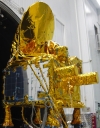
|
Mars
Orbiter Mission
MOM
Mangalyaan
#39370
(2013-060A) |
Mars Orbiter Mission
(MOM), also called Mangalyaan,
is India's (ISRO) first interplanetary mission to Mars.
It is designed to orbit Mars in an elliptical orbit
(366km x 80000km, 150° inclination). It left Earth
orbit and headed for Mars on December 1st
2013. After a 300-day cruise an orbital insertion burn
on September 24th 2014 put
MOM in an elliptical 76.7 hr Mars orbit. The Mission
is primarily a technological mission considering the
critical mission operations and stringent requirements
on propulsion and other bus systems of the spacecraft.
Communications are via a 2.2 m S-band high gain antenna,
a medium gain antenna, and a low gain antenna. ITU published
the following S-band downlink frequencies: 2217.120
MHz, 2222.290 MHz, 2230.800 MHz, 2292.960 MHz, 2296.000
MHz and 2298.480 MHz. |
Nov.
5th
2013 |
488
kg |
  The S-Band
signals from MOM on 2298.516 MHz and 2292.980 MHz were
received on November 9th The S-Band
signals from MOM on 2298.516 MHz and 2292.980 MHz were
received on November 9th   2013
at 17:36 UTC and 18:04 UTC by Paul M0EYT. Spectrum plots
and recordings kindly provided by Paul Marsh M0EYT. 2013
at 17:36 UTC and 18:04 UTC by Paul M0EYT. Spectrum plots
and recordings kindly provided by Paul Marsh M0EYT.
|
 The
signal from MOM, while it was 11 Mio km away from Earth,
was received at 2298.48 MHz on January 14th
2014 from 00:00 until 12:45 UTC by DF2MZ. The doppler-shift
originated mainly by the Earth rotation, the frequency
jumps most likely by the handover of the ground stations.
Spectrum plot kindly provided by Edgar J. Kaiser DF2MZ. The
signal from MOM, while it was 11 Mio km away from Earth,
was received at 2298.48 MHz on January 14th
2014 from 00:00 until 12:45 UTC by DF2MZ. The doppler-shift
originated mainly by the Earth rotation, the frequency
jumps most likely by the handover of the ground stations.
Spectrum plot kindly provided by Edgar J. Kaiser DF2MZ.
|
 Paul
M0EYT received the S-Band signal from MOM on 2292.955
MHz again on February 15h 2015
at 12:07 UTC while MOM was at a distance of 325 Mio
km. Spectrum plot kindly provided by Paul Marsh M0EYT. Paul
M0EYT received the S-Band signal from MOM on 2292.955
MHz again on February 15h 2015
at 12:07 UTC while MOM was at a distance of 325 Mio
km. Spectrum plot kindly provided by Paul Marsh M0EYT.
|
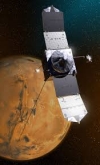
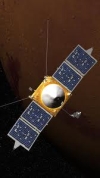

|
MAVEN
Mars Scout 2
#39378
(2013-063A / SSC) |
The Mars Atmosphere and
Volatile EvolutioN (MAVEN) mission is designed to explore
Mars' upper atmosphere and ionosphere, and interactions
with the solar wind, specifically to determine the loss
of volatile compounds to space through time and how
it has affected the history of Mars' atmosphere and
climate. After arriving at Mars in the fall of 2014,
NASA's spacecraft MAVEN will use its propulsion system
to enter an elliptical orbit ranging 90 to 3,870 miles
above the planet. MAVEN transmits on 8444.800 MHz with
2 sidebands 1.023 MHz either side of the carrier. |
Nov.
18th
2013 |
809
kg |
  The X-Band
signal from MAVEN was received on November 19th
2013 at 08:34 UTC on 8445.606 MHz by Paul M0EYT. Spectrum
plot and recording kindly provided by Paul Marsh M0EYT. The X-Band
signal from MAVEN was received on November 19th
2013 at 08:34 UTC on 8445.606 MHz by Paul M0EYT. Spectrum
plot and recording kindly provided by Paul Marsh M0EYT.
|


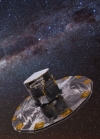
|
Gaia
#39479
(2013-074A) |
Gaia (Global Astrometric
Interferometer for Astrophysics) is an ambitious mission
to chart a three-dimensional map of our Galaxy, the
Milky Way, in the process revealing the composition,
formation and evolution of the Galaxy. Gaia is a fully
European mission designed, built and operated by ESA.
The Gaia Data Processing and Analysis Consortium (DPAC)
will process the raw data to be published in the largest
stellar catalogue ever made. Gaia will operate in a
Lissajous-type orbit, around the L2 (Lagrangian point
2) point of the Sun-Earth system, which is located 1.5
million km from the Earth in the anti-Sun direction.
The orbit is not impacted by Earth eclipses. The orbit
period is about 180 days and the size of the orbit is
typically 340 000 × 90 000 km. An operational
lifetime of 5 years is planned. Gaia tranmits in X-band
on 8465 MHz in 2 downlink modes (6.8 MHz and 10 MHz
wide) and receives at 7204.8693 MHz. Up- and downlink
frequencies are at a ratio of 749/880 to allow coherent
ranging. |
Dec.
19th
2013 |
1392
kg |
  The X-Band
signal from Gaia was received on December 20th
2013 at 19:57 UTC on 8464.95 MHz by Paul M0EYT. Spectrum
plot and recording kindly provided by Paul Marsh M0EYT. The X-Band
signal from Gaia was received on December 20th
2013 at 19:57 UTC on 8464.95 MHz by Paul M0EYT. Spectrum
plot and recording kindly provided by Paul Marsh M0EYT.
|
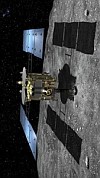
|
Hayabusa-2
#40319
(2014-076A) |
Asteroid
Explorer Hayabusa-2 was launched on December 3rd 2014
at 04:22 UTC by H-IIA
Launch Vehicle No. 26 (H-IIA F26) on an Earth escape
trajectory. It will explore Asteroid (162173) 1999 JU3
and includes a small lander robot called Mascot (Mobile
Asteroid Surface Scout). Hayabusa-2 was built by JAXA
, Mascot was built by DLR Germany.The expected X and
Ka band downlink frequencies are:
8406.664
bw 100KHz
8421.064 bw 100KHz
8245.864 bw 7800MHz
<- probably main TTC
8430.664 bw 100KHz
8445.064
bw 100KHz
31999.090 bw 100KHz
32013.480 bw 100KHz
32018.280 bw 11500KHz <- probably main Ka TTC
32023.080 bw 100KHz
32037.480 bw 100KHz
HGA
seems to be 37dB gain at X and 47dB gain at Ka. LGA's
of 7dB gain and 20dB gain are also present. Seems Ka
only can use the HGA |
Dec.
3rd
2014 |
600
kg |
  The X-Band
signal from Hayabusa-2 was received on December 7th
2014 at 23:08 UTC on 8425.864198
MHz by Paul M0EYT. At the time of reception
the distance from Hayabusa-2 to Earth was 1.938 Mio.
km. Spectrum plot and recording kindly provided by Paul
Marsh M0EYT. The X-Band
signal from Hayabusa-2 was received on December 7th
2014 at 23:08 UTC on 8425.864198
MHz by Paul M0EYT. At the time of reception
the distance from Hayabusa-2 to Earth was 1.938 Mio.
km. Spectrum plot and recording kindly provided by Paul
Marsh M0EYT.
|
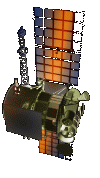
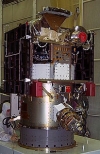

|
DSCOVR
#40390
(2015-007A) |
Deep Space Climate Observatory
(DSCOVR) provides
real-time solar wind monitoring capabilities which are
critical to the accuracy and lead time of NOAA's space
weather alerts and forecasts. Without timely and accurate
warnings, space weather events like the geomagnetic
storms caused by changes in solar wind have the potential
to disrupt nearly every major public infrastructure
system, including power grids, telecommunications, aviation
and GPS. It operates at the Lagrange-1,
or L1 (the neutral gravity point between the Sun and
the Earth). It was launched on a Falcon 9 rocket from
Cape Canaveral in Florida. |
Feb.
11th
2015 |
570
kg |
  DSCOVR
was first received by Edgar Kaiser DF2MZ on February
13th 2015 at 10:30 UTC. He
found the downlink signal on 2214.990 MHz while DSCOVR
was at a distance of approx. 450000 km on its way to
L1. Waterfall plot and audio recording kindly provided
by Edgar DF2MZ. DSCOVR
was first received by Edgar Kaiser DF2MZ on February
13th 2015 at 10:30 UTC. He
found the downlink signal on 2214.990 MHz while DSCOVR
was at a distance of approx. 450000 km on its way to
L1. Waterfall plot and audio recording kindly provided
by Edgar DF2MZ.
|
 Also M0EYT
received DSCOVR on February 13th
2015 at 14:46 UTC. Audio recording kindly provided by
Paul Marsh M0EYT. Also M0EYT
received DSCOVR on February 13th
2015 at 14:46 UTC. Audio recording kindly provided by
Paul Marsh M0EYT.
|
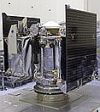
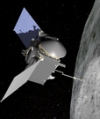
|
OSIRIS-REx
#OSIRISREX
(2016-055A) |
The Origins, Spectral
Interpretation, Resource Identification, Security, Regolith
Explorer (OSIRIS-REx) is a asteroid study and sample
return mission. The satellite launched by NASA is to
study asteroid 101955 Bennu, a carbonaceous asteroid,
and in 2023 to return a sample to Earth for detailed
analysis. The material returned is expected to enable
scientists to learn more about the formation and evolution
of the Solar System, its initial stages of planet formation,
and the source of organic compounds that led to the
formation of life on Earth. If successful, OSIRIS-REx
will be the first US spacecraft to return samples from
an asteroid. |
Sept.
8th
2016 |
1529
kg |
M0EYT received OSIRIS-REx
on September 9th 2016 and made
enclosed screenshots of the spectrum.
 The
first spectrum was recorded on September 9th
2016 at 08:17 UTC. The spacecraft was at a distance
of 192500 km and the signal at 8.44559757 GHz was very
strong. The
first spectrum was recorded on September 9th
2016 at 08:17 UTC. The spacecraft was at a distance
of 192500 km and the signal at 8.44559757 GHz was very
strong.
 The
second spectrum was recorded on September 9th
2016 at 08:43 UTC. The signal at 8.44559753 GHz shows
clearly the ranging tones. The
second spectrum was recorded on September 9th
2016 at 08:43 UTC. The signal at 8.44559753 GHz shows
clearly the ranging tones.
 This audio
recording of the carrier on 8.445597200 GHz was recorded
on September 9th 2016 at 09:14
UTC. This audio
recording of the carrier on 8.445597200 GHz was recorded
on September 9th 2016 at 09:14
UTC.
Spectrum plots and audio recording kindly provided
by Paul Marsh M0EYT. |
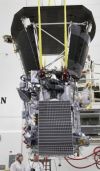
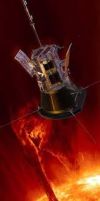
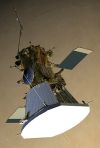
|
Parker
Solar Probe PSP
Solar Probe Plus SPP
(2018-065A) |
The
Solar Probe Plus mission, renamed to Parker Solar Probe
in May 2017, will study the streams of charged particles
the sun hurls into space from a vantage point within
the sun's corona – its outer atmosphere – where the
processes that heat the corona and produce solar wind
occur. At closest approach Solar Probe would zip past
the sun at 201 km/s, protected by a carbon-composite
heat shield that must withstand up to 1430 degrees Celsius
and survive blasts of radiation and energized dust at
levels not experienced by any previous spacecraft. Solar
Probe is part of NASA's Living with a Star Program,
designed to learn more about the sun and its effects
on planetary systems and human activities. The compact,
solar-powered probe has a weight of about 1,000 pounds.
The design includes a 2.7 m diameter, 15 cm thick, carbon-foam-filled
solar shield atop the spacecraft body. Two sets of solar
arrays retract or extend as the spacecraft swings toward
or away from the sun during several loops around the
inner solar system, making sure the panels stay at proper
temperatures and power levels. At its closest passes
the spacecraft must survive solar intensity more than
500 times what spacecraft experience while orbiting
Earth. |
Aug.
12th
2018 |
685
kg |
M0EYT received SPP on
August 12th 2018 soon after
its launch.
 The
first spectrum was recorded on August 12th
2018 at 15:25 UTC at 8.43095145 GHz. The
first spectrum was recorded on August 12th
2018 at 15:25 UTC at 8.43095145 GHz.
 The
second spectrum was recorded on August 12th
2018 at 15:41 UTC. The signal at 8.43095144 GHz shows
two sidebands. The
second spectrum was recorded on August 12th
2018 at 15:41 UTC. The signal at 8.43095144 GHz shows
two sidebands.
 This audio
recording of the carrier on 8.43095144 GHz was recorded
on August 12th 2018 at 15:41
UTC. This audio
recording of the carrier on 8.43095144 GHz was recorded
on August 12th 2018 at 15:41
UTC.
Spectrum plots and audio recording kindly provided
by Paul Marsh M0EYT. |
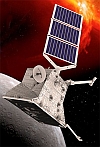
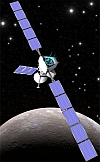
|
BepiColombo
(2018-080A) |
BepiColombo,
a mission of ESA and ISAS/JAXA, will explore Mercury,
the innermost planet of our solar system. It was launched
in October 20th 2018 by an
Ariane 5ECA launcher from Korou.
The mission consists
of two separate spacecraft that will orbit the planet.
The European Space Agency ESA built the main spacecraft,
the Mercury Planetary Orbiter (MPO), and the Japanese
space agency ISAS/JAXA is contributing the other, the
Mercury Magnetospheric Orbiter (MMO).
MPO will study
the surface and internal composition of the planet,
and MMO will study Mercury's magnetosphere, which is
the region of space around the planet that is dominated
by its magnetic field.
BepiColombo is
ESAs first experience of sending a spacecraft to a planet
so close to the sun and the first mission overall to
Mercury. The spacecraft must brake against the Sun's
gravity, which increases with proximity to the Sun,
rather than accelerate away from it, as is the case
with journeys to the outer Solar System. BepiColombo
will accomplish this by making clever use of the gravity
of the Moon, Venus and Mercury by performing 9 flybys
and by using a solar electric propulsion (SEP) system.
After its 7.2 years journey to Mercury, in December
2025 the spacecraft will use the planet's gravity plus
a conventional rocket engine to insert itself into a
polar orbit. In orbit, the two mercury orbiters will
separate from the cruise stage and conduct their observations
from orbit individually for at least one Earth year. |
Oct.
20th
2018 |
4100
kg |
M0EYT received BepiColombo
on October 20th 2018 soon after
its launch.
 The
first spectrum was recorded on October 20th
2018 at 07:06 UTC at 8.42031297 GHz. The
first spectrum was recorded on October 20th
2018 at 07:06 UTC at 8.42031297 GHz.
 The
second spectrum was recorded a few minutes later and
shows both sidebands. The
second spectrum was recorded a few minutes later and
shows both sidebands.
 The
third spectrum was also taken on October 20th 2018 at
10:48 UTC. It shows how the transmitter of BepiColombo
locks to the uplink signal from the groundstation. The
third spectrum was also taken on October 20th 2018 at
10:48 UTC. It shows how the transmitter of BepiColombo
locks to the uplink signal from the groundstation.
 This audio
recording of the carrier on 8.4203100 GHz was recorded
on October 20th 2018 at 11:00
UTC. This audio
recording of the carrier on 8.4203100 GHz was recorded
on October 20th 2018 at 11:00
UTC.
Spectrum plots and audio recording kindly provided
by Paul Marsh M0EYT.
|
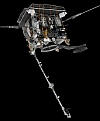
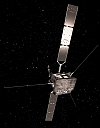
|
ESA Solar Orbiter
SolO
(2020-010A) |
Solar
Orbiter is a mission dedicated to solar and heliospheric
physics. It was selected as the first medium-class mission
of ESA's Cosmic Vision 2015-2025 Programme. The programme
outlines key scientific questions which need to be answered
about the development of planets and the emergence of
life, how the Solar System works, the origins of the
Universe, and the fundamental physics at work in the
Universe. |
Feb.
10th
2020 |
1800
kg |
 M0EYT
received ESA Solar Orbiter two days after its launch
on February 12th 2018 at 18:26
UTC. M0EYT
received ESA Solar Orbiter two days after its launch
on February 12th 2018 at 18:26
UTC.  Enclosed
audio file and associated spectrum was recorded at 8.4270603157
GHz and kindly provided by Paul Marsh M0EYT. Enclosed
audio file and associated spectrum was recorded at 8.4270603157
GHz and kindly provided by Paul Marsh M0EYT.
|
 On February
13th 2020 Paul M0EYT received
ESA Solar Orbiter, which had switched to the high gain
antenna. The signals were very strong and showed a periodic
fading about every 3 seconds. On February
13th 2020 Paul M0EYT received
ESA Solar Orbiter, which had switched to the high gain
antenna. The signals were very strong and showed a periodic
fading about every 3 seconds.
|
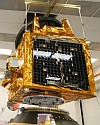
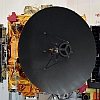



|
Emirates Mars Mission EMM
HOPE
(2020-047A) |
Emirates
Mars Mission (EMM), also known as Al-Amal or Hope, is
the first Arab mission to Mars. This 3-axis stabilized
probe from the UAE Space Agency was jointly developed
and built at Mohammed bin Rashid Space Centre (MBRSC)
and at the Laboratory for Atmospheric and Space Physics,
at the University of Colorado at Boulder. HOPE was launched
on July 19th 2020 on a Japanese
H-2A-202 rocket and its arrival at Mars will be in 2021.
It will enter an elliptical 22000 km × 44000 km
Mars orbit with a 55 day period. The mission is planned
to last until 2023, with a possible mission extension
until 2025.
The spacecraft
is 2.37 m wide by 2.90 m tall when the including two
600 Watt solar panels are folded flat against the sides
of the probe for launch. Once the probe was in orbit
the solar panels were unfold. The probe communicates
with Mission Control either by a high-gain antenna (1.5
m dish) or by a low-gain antenna. Communication bandwidth
will be from 1.6 Mbps near earth to 250 kbps at Mars.
The probe carries
the following science instruments:
EXI (Emirates eXploration
Imager) - A multi-band imager designed by Emirati and
U.S. engineers at the University of Colorado capable
of taking high-resolution images of the Martian surface,
with a spatial resolution of better than 8 km in three
ultraviolet (UV) and three RGB bands.
EMIRS (Emirates
Mars InfaRed Spectrometer) - An Infra-Red Spectrometer
developed by Arizona State University which will examine
temperature patterns, ice, water vapour and dust in
the atmosphere.
EMUS (Emirates
Mars Ultraviolet Spectrometer) - An Ultraviolet Spectrometer
designed by Emirati and U.S. engineers at the University
of Colorado which will study the upper atmosphere and
traces of oxygen and hydrogen further out into space. |
July
19th
2020 |
1350
kg |
M0EYT received HOPE July
19th 2020 soon after its launch.
  The
first recording was was done on July 19th
2018 at 23:29 UTC at 8.401622 GHz. The
first recording was was done on July 19th
2018 at 23:29 UTC at 8.401622 GHz.
 The second
recording was done on July 20th
2018 at The second
recording was done on July 20th
2018 at  07:08
UTC at 8.402656 GHz. EMM was transmitting with 10kbps. 07:08
UTC at 8.402656 GHz. EMM was transmitting with 10kbps.
|
Also Edgar DF2MZ successfully
received EMM shortly after its launch.  Enclosed
spectrogram was recorded by him on July 20th
2020 from 09:20h UTC until 10:40h UTC. Enclosed
spectrogram was recorded by him on July 20th
2020 from 09:20h UTC until 10:40h UTC. |
 Here
is a very interesting long time spectrogram which Edgar
DF2MZ recorded over about 12 hours on July 20th
to 21st 2020. Here
is a very interesting long time spectrogram which Edgar
DF2MZ recorded over about 12 hours on July 20th
to 21st 2020.
|
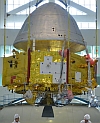

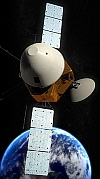
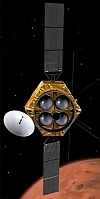 

|
Tianwen
1
(Huoxing 1, HX 1)
(2020-049A) |
Tianwen
1 is a planetary mission from China to Mars. It consists
of two parts: an orbiter and a lander which carries
a rover. It was launched on July 27th
2020 on a CZ-5/YZ2 rocket from the new Wenchang spaceport
in China. |
July
23rd
2020 |
1350
kg |
  Paul M0EYT
received the Tiawen-1 downlink at 8430.879 MHz on July
23rd 2020 at 06:42 UTC and Paul M0EYT
received the Tiawen-1 downlink at 8430.879 MHz on July
23rd 2020 at 06:42 UTC and
 at
07:03 UTC. It had switched from its low gain antenna
to the high gain antenna. The Audio recording is from
06:26 UTC at the same day. at
07:03 UTC. It had switched from its low gain antenna
to the high gain antenna. The Audio recording is from
06:26 UTC at the same day.
|
 Paul
M0EYT received the Tiawen-1 downlink at 8430.91111 MHz
on July 24th 2020 at 07:45
UTC. Paul
M0EYT received the Tiawen-1 downlink at 8430.91111 MHz
on July 24th 2020 at 07:45
UTC.
|
 Paul
M0EYT received the Tiawen-1 downlink at 8430.91111 MHz
on July 26th 2020 at 05:10
UTC. Paul
M0EYT received the Tiawen-1 downlink at 8430.91111 MHz
on July 26th 2020 at 05:10
UTC.
|
 Paul
M0EYT received the Tiawen-1 downlink at 8430.91111 MHz
on July 27th 2020 at 05:11
UTC. Paul
M0EYT received the Tiawen-1 downlink at 8430.91111 MHz
on July 27th 2020 at 05:11
UTC.
|
Also Edgar DF2MZ successfully
received Tianwen-1 since shortly after its launch.  Enclosed
interesting long time spectrogram was recorded by him
on July 29th 2020 over a period
of about 12 hours and shows multiple locking and unlocking
activities of the spacecraft with different basestations. Enclosed
interesting long time spectrogram was recorded by him
on July 29th 2020 over a period
of about 12 hours and shows multiple locking and unlocking
activities of the spacecraft with different basestations. |
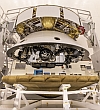




|
Mars
2020
Perseverance
(2020-052A) |
Mars 2020
is a planetary rover mission from NASA to Mars. Its
main goal is to answer important questions about potential
life on Mars. Besides the rover Perseverance it also
includes a 1.8kg helicopter named Ingenuity. Mars 2020
was launched on July 30th 2020
on ATLAS V-541 from Cape Canaverial/Florida.
 NASA
had an initiative "send you name to Mars"
where interested people could submit their names and
they were stored on the spacecraft. Every participant
received a "boarding pass". NASA
had an initiative "send you name to Mars"
where interested people could submit their names and
they were stored on the spacecraft. Every participant
received a "boarding pass".
As per ITU the
spacecraft TX freq is 8415.000MHz and can be tracked
on horizons with Mars2020 spacecraft (Perseverance). |
July
30th
2020 |
3839
kg |
 Paul
M0EYT received MARS 2020 Cruise Stage Downlink at 8414.881
MHz on July 30th 2020 at 21:53
UTC. Paul
M0EYT received MARS 2020 Cruise Stage Downlink at 8414.881
MHz on July 30th 2020 at 21:53
UTC.
|
 Paul
M0EYT received MARS 2020 Cruise Stage Downlink at 8414.881
MHz on July 30th 2020 at 22:05
UTC. Paul
M0EYT received MARS 2020 Cruise Stage Downlink at 8414.881
MHz on July 30th 2020 at 22:05
UTC.
|
 About
one week after launch Paul M0EYT received the Mars 2020
downlink at 8414.881 MHz on August 6th
2020 at 07:20 UTC. About
one week after launch Paul M0EYT received the Mars 2020
downlink at 8414.881 MHz on August 6th
2020 at 07:20 UTC.
|
Also Edgar DF2MZ successfully
received Mars 2020 shortly after its launch.  Enclosed
spectrogram was recorded by him on July 31st
2020 around 10:15h UTC. The spacecraft unlocked from
an unknown basestation at 10:10 UTC, remained free drifting
until 10:21 UTC and then locked to Goldstone DSS24 at
10:25 UTC. At the time of recording the spacecraft was
at a distance of about 357000 km. Enclosed
spectrogram was recorded by him on July 31st
2020 around 10:15h UTC. The spacecraft unlocked from
an unknown basestation at 10:10 UTC, remained free drifting
until 10:21 UTC and then locked to Goldstone DSS24 at
10:25 UTC. At the time of recording the spacecraft was
at a distance of about 357000 km. |
Picture |
Object
name
#NORAD |
Description |
Launch
Date |
Weight |